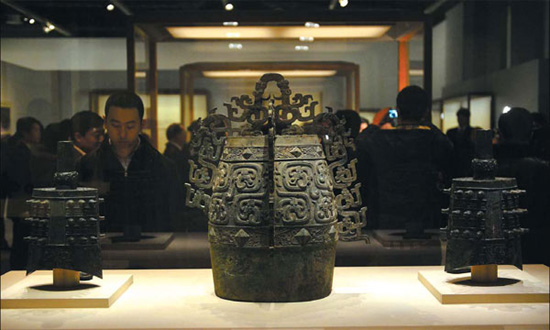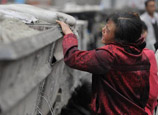
 |
| Visitors are fascinated by bronze ware displayed at the Watching and Guarding Home Exhibition, at the National Museum of China. (China Daily/Jiang Dong) |
The communities of Baoji are forever linked with China's ancient metallurgy. Wang Kaihao reports on the pride and the preservation.
For residents in Baoji, Shaanxi province, also known as "the hometown of bronze ware", protecting historical treasures is one way to safeguard their homeland. At least, that is what they want to express through a compelling exhibition at the National Museum of China in Beijing.
The one-month free exhibition Watching and Guarding Home continues through March 31. It includes 156 bronze artifacts ranging from sacrificial vessels to musical instruments, all accidentally discovered by Baoji's residents since 1975.
"It's not too exaggerated to say these are national treasures," says Yan Zhi, the museum archaeologist and also the curator of this exhibition.
Yan says that among the exhibits, 62 items have been appraised as national grade-one artifacts and 76 are still waiting to be graded. He estimates two-thirds of the exhibits will be top-graded national treasures.
"And it is not often that our museum is able to exhibit such a huge number of rare antiques, and all of them were discovered by local villagers."
Baoji was the birthplace of Western Zhou Dynasty (c. 11th century-771 BC) and a major cultural hub in the following centuries. Innumerable items of bronze ware, symbolic ancient Chinese artifacts, have been unearthed in the area. Yan says 90 percent of the nation's bronze ware carved with long inscriptions was found around Baoji.
Yan adds this is also the first time that more than 100 bronze artifacts from Baoji has ever been assembled outside of Shaanxi province.
 |
















 Photo story: Brave young mother in the 4th year of university
Photo story: Brave young mother in the 4th year of university


![]()
